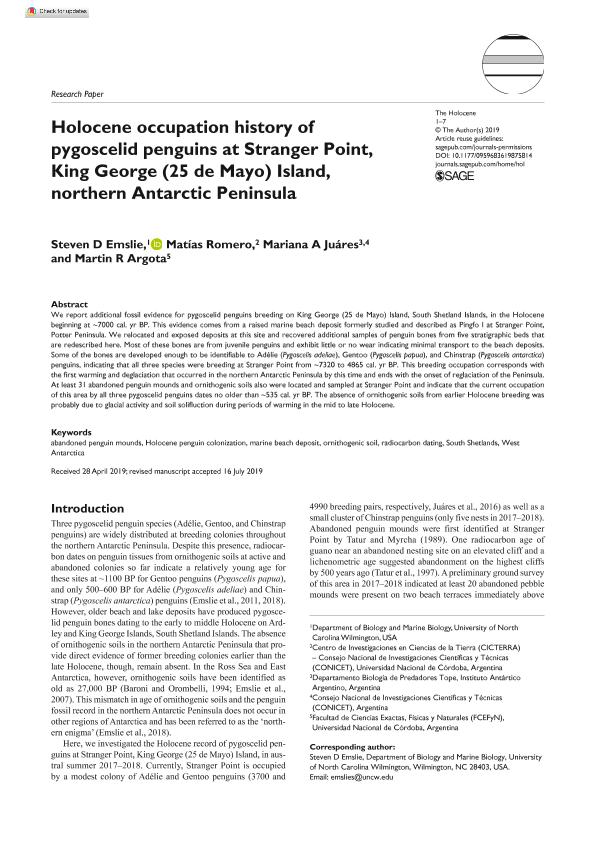Mostrar el registro sencillo del ítem
dc.contributor.author
Emslie, Steven Douglas

dc.contributor.author
Romero, Matias

dc.contributor.author
Juares, Mariana Alejandra

dc.contributor.author
Argota, Martin R.
dc.date.available
2022-11-01T12:53:42Z
dc.date.issued
2019-09
dc.identifier.citation
Emslie, Steven Douglas; Romero, Matias; Juares, Mariana Alejandra; Argota, Martin R.; Holocene occupation history of pygoscelid penguins at Stranger Point, King George (25 de Mayo) Island, northern Antarctic Peninsula; Sage Publications Ltd; Holocene (Seven Oaks); 30; 1; 9-2019; 190-196
dc.identifier.issn
0959-6836
dc.identifier.uri
http://hdl.handle.net/11336/175794
dc.description.abstract
We report additional fossil evidence for pygoscelid penguins breeding on King George (25 de Mayo) Island, South Shetland Islands, in the Holocene beginning at ~7000 cal. yr BP. This evidence comes from a raised marine beach deposit formerly studied and described as Pingfo I at Stranger Point, Potter Peninsula. We relocated and exposed deposits at this site and recovered additional samples of penguin bones from five stratigraphic beds that are redescribed here. Most of these bones are from juvenile penguins and exhibit little or no wear indicating minimal transport to the beach deposits. Some of the bones are developed enough to be identifiable to Adélie (Pygoscelis adeliae), Gentoo (Pygoscelis papua), and Chinstrap (Pygoscelis antarctica) penguins, indicating that all three species were breeding at Stranger Point from ~7320 to 4865 cal. yr BP. This breeding occupation corresponds with the first warming and deglaciation that occurred in the northern Antarctic Peninsula by this time and ends with the onset of reglaciation of the Peninsula. At least 31 abandoned penguin mounds and ornithogenic soils also were located and sampled at Stranger Point and indicate that the current occupation of this area by all three pygoscelid penguins dates no older than ~535 cal. yr BP. The absence of ornithogenic soils from earlier Holocene breeding was probably due to glacial activity and soil solifluction during periods of warming in the mid to late Holocene.
dc.format
application/pdf
dc.language.iso
eng
dc.publisher
Sage Publications Ltd

dc.rights
info:eu-repo/semantics/openAccess
dc.rights.uri
https://creativecommons.org/licenses/by-nc-sa/2.5/ar/
dc.subject
ABANDONED PENGUIN MOUNDS
dc.subject
HOLOCENE PENGUIN COLONIZATION
dc.subject
MARINE BEACH DEPOSIT
dc.subject
ORNITHOGENIC SOIL
dc.subject
RADIOCARBON DATING
dc.subject
SOUTH SHETLANDS
dc.subject
WEST ANTARCTICA
dc.subject.classification
Paleontología

dc.subject.classification
Ciencias de la Tierra y relacionadas con el Medio Ambiente

dc.subject.classification
CIENCIAS NATURALES Y EXACTAS

dc.title
Holocene occupation history of pygoscelid penguins at Stranger Point, King George (25 de Mayo) Island, northern Antarctic Peninsula
dc.type
info:eu-repo/semantics/article
dc.type
info:ar-repo/semantics/artículo
dc.type
info:eu-repo/semantics/publishedVersion
dc.date.updated
2022-10-24T17:48:22Z
dc.journal.volume
30
dc.journal.number
1
dc.journal.pagination
190-196
dc.journal.pais
Estados Unidos

dc.description.fil
Fil: Emslie, Steven Douglas. University of North Carolina; Estados Unidos
dc.description.fil
Fil: Romero, Matias. Consejo Nacional de Investigaciones Científicas y Técnicas. Centro Científico Tecnológico Conicet - Córdoba. Centro de Investigaciones en Ciencias de la Tierra. Universidad Nacional de Córdoba. Facultad de Ciencias Exactas Físicas y Naturales. Centro de Investigaciones en Ciencias de la Tierra; Argentina
dc.description.fil
Fil: Juares, Mariana Alejandra. Consejo Nacional de Investigaciones Científicas y Técnicas; Argentina. Ministerio de Relaciones Exteriores, Comercio Interno y Culto. Dirección Nacional del Antártico. Instituto Antártico Argentino; Argentina
dc.description.fil
Fil: Argota, Martin R.. Universidad Nacional de Córdoba. Facultad de Ciencias Exactas, Físicas y Naturales; Argentina
dc.journal.title
Holocene (Seven Oaks)

dc.relation.alternativeid
info:eu-repo/semantics/altIdentifier/url/http://journals.sagepub.com/doi/10.1177/0959683619875814
dc.relation.alternativeid
info:eu-repo/semantics/altIdentifier/doi/http://dx.doi.org/10.1177/0959683619875814
Archivos asociados
